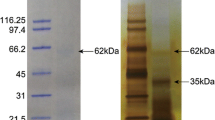Abstract
The dissolution of calcified invertebrate skeletons releases an elaborate mixture of proteins, glycoproteins and polysaccharides. These ‘skeletal matrix’ macromolecules are thought to play a major role in calcification and were widely used for phylogenetical studies. We tested the reactivity of water-soluble macromolecules from a wide range of invertebrate skeletons with two antisera raised against the shell matrix of the bivalve, Pinna nobilis. Projections of our results on the phylogenetical tree of Starobogatov (1992) show for the first time that, during evolution, antigenic determinants may degenerate in some stocks while they remain intact in others. The phylogenetic implications of these patterns of disjunct degeneration are discussed.
Similar content being viewed by others
References
Adamkewicz, S.L., M.G. Harasewych, J. Blake, D. Saudek & C.J. Bult 1997 A molecular phylogeny of the bivalve mollusks-Mol. Biol. Evol. 14: 619–629
Clark, N.F. & A.N. Adams 1977 Characteristics of the microplate method of enzyme-linked immunosorbent assay for the detection of plant viruses-J. Gen. Virol. 34: 475–483
Cohen, B.L. 1992 Utility of molecular phylogenetic methods: a critique of immuno-taxonomy-Lethaia 25: 441–442
Collins, M.J., G.B. Curry, G. Muyzer, R. Quinn, T. Zomerdijk & P. Westbroek 1988 Sero-taxonomy of skeletal macromolecules in living terebratulid brachiopods-Histor. Biol. 1: 207–224
Collins, M.J., G. Muyzer, P. Westbroek, G.B. Curry, P.A. Sandberg, S.J. Xu, R. Quinn & D. MacKinnon 1991a Preservation of fossil biopolymeric structures: conclusive immunological evidence-Geochim. Cosmochim. Acta 55: 2253–2257
Collins, M.J., G. Muyzer, G.B. Curry, P. Sandberg & P. Westbroek 1991b Macromolecules in brachiopod shells: characterization and diagenesis-Lethaia 24: 387–397
Collins, M.J., P. Westbroek, G. Muyzer & J.W. de Leeuw 1992 Experimental evidence for condensation reactions between sugars and proteins in carbonate skeletons-Geochim. Cosmochim. Acta 56: 1539–1544
Cope, J.C.W. 1996 The early evolution of the Bivalvia. In: Taylor, J. (ed.) Origin and Evolutionary Radiation of the Mollusca-Oxford Univ. Press, Oxford: 361–370
Crenshaw, M.A. 1972 The soluble matrix from Mercenaria mercenaria shell-Biomineralization 6: 6–11
Endo, K., G.B. Curry, R. Quinn, M.J. Collins, G. Muyzer & P. Westbroek 1994 Re-interpretation of terebratulide phylogeny based on immunological data-Paleontology 37: 349–373
Endo, K., D. Walton, R.A. Reyment & G.B. Curry 1995 Fossil intra-crystalline biomolecules of brachiopod shells: diagenesis and preserved geo-biological information-Org. Geochem. 23: 661–673
Faye, L. & M.J. Chrispeels 1988 Common antigenic determinants in the glycoproteins of plants, molluscs and insects-Glycoconjugate J. 5: 245–256
Gaffey, S.J. 1988 Water in skeletal carbonates-J. Sedim. Petrol. 58: 397–414
Harlow, E. & D. Lane 1988 Antibodies, a Laboratory Manual-Cold Spring Harbor Lab. Publ., Cold Spring Harbor, NY
Harte, M.E. 1992 A new approach to the study of bivalve evolution-Amer. Malacol. Bull. 9: 199–206
Lowenstam, H.A. & S. Weiner 1989 On Biomineralization-Oxford Univ. Press, New York
Lowenstein, J.M. & O.A. Ryder 1985 Immunological systematics of the extinct quagga (Equidae)-Experientia 41: 1192–1193
Lowenstein, J.M. & G. Scheuenstuhl 1991 Immunological methods in molecular palaeontology-Phil. Trans. R. Soc. Lond. B 333: 375–380
Marin, F., G. Muyzer & Y. Dauphin 1994 Caractérisation électrophorétique et immunologique des matrices organiques solubles des tests de deux bivalves ptériomorphes actuels, Pinna nobilis L. et Pinctada margaritifera (L.)-C. R. Acad. Sci. Paris (sér. II) 318: 1653–1659
Morton, B. 1996 The evolutionary history of the Bivalvia. In: Taylor, J. (ed.) Origin and Evolutionary Radiation of the Mollusca. Oxford Univ. Press, Oxford: 337–359
Muyzer, G., P. Westbroek, J.P.M. de Vrind, J. Tanke, T. Vrijheid, E.W. de Jong, J.W. Bruning & J.F. Wehmiller 1984 Immunology and organic geochemistry-Org. Geochem. 6: 847–855
Muyzer, G. & P. Westbroek 1988 Phylogenetic implications and diagenetic stability of macromolecules from Pleistocene and recent shells of Mercenaria mercenaria (Mollusca, Bivalvia)-Histor. Biol. 1: 135–144
Olsen-Stojkovich, J., J.A. West & J.M. Lowenstein 1986 Phylogenetics and biogeography in the Cladophorales complex (Chlorophyta): some insights from immunological distance data-Botan. Marina 29: 239–249
Prager, E.M. & A.C. Wilson 1971 The dependence of immunological cross-reactivity upon sequence resemblance among lyzozymes-J. Biol. Chem. 246: 5978–5989
Robbins, L.L., G. Muyzer & K. Brew 1993 Macromolecules from living and fossil biominerals. Implications for the establishment of molecular phylogenies. In: Engel, M.H. & S.A. Macko (eds) Organic Geochemistry. Plenum Press, New York: 799–816
Salvini-Plawen, L. & G. Steiner 1996 Synapomorphies and plesiomorphies in higher classification of Mollusca. In: Taylor, J. (ed.) Origin and Evolutionary Radiation of the Mollusca. Oxford Univ. Press, Oxford: 29–51
Sarich, V.M. & A.C. Wilson 1966 Quantitative immunochemistry and the evolution of primate albumins: microcomplement fixation-Science 154: 1563–1566
Simon, A., M. Poulicek, R. Machiroux & J. Thorez 1990 Biodégradation anaérobique des structures squelettiques en milieu marin: II approche chimique-Cahiers Biol. Mar. 31: 365–384
Starobogatov, Y.I. 1992 Morphological basis for phylogeny and classification of Bivalvia-Ruthenica 2: 1–25
Waller, T.R. 1997 Origin of the molluscan class Bivalvia and a phylogeny of major groups. In: Johnston, P.A. & J.W. Haggart (eds) Bivalves: An Eon of Evolution, Univ. Calgary Press: 1–45
Weiner, S., L. Hood 1975 Soluble protein of the organic matrix of mollusc shells: a potential template for shell formation-Science 190: 987–989
Weiner, S., H.A. Lowenstam, B. Taborek & L. Hood, L. 1979 Fossil mollusk shell organic matrix components preserved for 80 million years-Paleobiology 5: 144–150
Weiner, S., W. Traub & H.A. Lowenstam 1983 Organic matrices in calcified exoskeletons. In: Westbroek, P. & E.W. de Jong (eds) Biomineralization and biological metal accumulation-D. Reidel Publ. Co., Dordrecht: 205–224
Wheeler, A.P., K.W. Rusenko, D.M. Swift & C.S. Sikes 1988 Regulation of in vitro and in vivo CaCO3 crystallization by fractions of oyster shell organic matrix-Mar. Biol. 98: 71–80
Author information
Authors and Affiliations
Rights and permissions
About this article
Cite this article
Marin, F., Gillibert, M., Westbroek, P. et al. Evolution: disjunct degeneration of immunological determinants. Geologie en Mijnbouw 78, 135–139 (1999). https://doi.org/10.1023/A:1003882928828
Issue Date:
DOI: https://doi.org/10.1023/A:1003882928828




